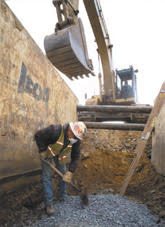 Trenching qualifies as one of the most dangerous activities in the water industry. Excavating to produce a cut that is deeper than it is wide is, by OSHA’s definition, creating a trench. Trenches are necessary to lay and repair water mains and pipes.
Trenching qualifies as one of the most dangerous activities in the water industry. Excavating to produce a cut that is deeper than it is wide is, by OSHA’s definition, creating a trench. Trenches are necessary to lay and repair water mains and pipes.
The hazards
The most common cause of fatalities are cave-ins, where the side-walls of the trench collapse due to instability. Such tragedies are the cause of many deaths and hundreds of accidents every year. Collapse is not the only danger that workers must be vigilant against: excavated materials or people falling, equipment falling and machine-related injuries are all risks.
Trench Safety
Workplace safety is key in such hazardous environments. Except when cut into stable rock, a trench reaching 5 feet deep is at risk of collapse. Any trench reaching a depth of 20 feet requires health and safety implementation designed by qualified professionals. Such safety systems include:
- Trench design
- Shoring
- Shielding
Trenches can be dug with sloping walls to reduce the likelihood of collapse. Shoring implements supports such as hydraulics to temporarily stabilise the walls whilst work is under way. Shielding is typically a box, or similar system for construction workers to work within.
One of the key OSHA requirements to safeguard workers is to ensure ease of access and exit. These safety standards state that for any trench of 4 feet or more there must be a means of exit within 25 feet of any employee.
Oversight
To maintain OSHA standards, excavations must be inspected every day to ensure good health and safety. Inspection must be carried out by a person competent at identifying risks within the work environment. The responsibility falls upon them to highlight dangerous or unhygienic conditions and to ensure that people or the person responsible take the appropriate corrective action.
Preventing fatalities
Pipe repair and installation is by its nature a dangerous undertaking, but cave-ins pose a greater risk of a fatality, rather than injury. The safety record is not good. Trench fatalities are on the increase, some reports put the death toll in 2016 as twice that of the previous two years combined. These incidents are preventable and occur because of non-compliance with the safety protocols provided.
Construction companies who are putting time and profit above training and protection are held responsible for these incidents. A recent criminal case was brought against a foreman and general contractor following a fatal collapse in New York. Contractors are also facing large fines; maximum penalty amounts have been increased recently to encourage compliance.
It is not only companies that are negligent, sometimes very experienced mains installation and repair workers take risks. It seems that complacency may creep in to an installer’s way of thinking, after so many years of getting into trenches every day with no ill consequences they begin to take risks, by not considering the risks.
Ultimately the water utilities and contractors must ensure that everyone on site is trained and compliant because yes, most days the trench will not collapse, but the cost in life when it does is simply too hig

